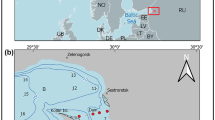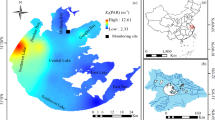Abstract
The penetration of sunlight into the water column plays a critical role in the aquatic ecosystem. The irradiance available for primary production in a water body depends on the incident light at the water surface, light extinction in the water column, and depth. In this study, the light attenuation through the water column of the Danshuei River–Keelung River estuary was estimated. The measurement of photosynthetically active radiation (PAR) indicates that the conventional exponential attenuation of light with depth is a very good model. A light attenuation coefficient may be derived from the PAR measurements at each location. The regression with salinity yields a good correlation, indicating that the fraction of seawater should be a good parameter for estimating the water column light attenuation coefficient (K d ). A laterally averaged two-dimensional finite difference model for hydrodynamic and water quality model was performed and applied to simulate the phytoplankton population at the lower reach of the Danshuei River estuary. In the process of phytoplankton population simulation, the regression model of K d and salinity was incorporated in the water quality model. The simulated results show that the modeled concentration of chlorophyll a matched the measured values at the lower reach of the Danshuei River estuary.










Similar content being viewed by others
References
Ambrose RB Jr, Wool TA, Connolly JP, Schanz RW (1988) WASP4, a hydrodynamic and water quality model: model theory, user’s manual and programmer’s guide. EPA/600/3-97/039. Environmental Research Lab (ERL), Office of Research and Development (ORD), US Environmental Protection Agency, Athens, GA
Bowie GL, Mills WB, Porcella DB, Campbell CL, Pagenkopf JR, Rupp GL, Jonson KM, Chan PWH, Gherini SA, Chamberlin CE (1985) Rates, constants, and kinetics formulations in surface water quality model, 2nd edn. EPA/600/3-85/040. Environmental Research Lab (ERL), Office of Research and Development (ORD), US Environmental Protection Agency, Athens, GA
Christian D, Sheng YP (2003) Relative influence of various water quality parameters on light attenuation in Indian River lagoon. Estuar Coast Shelf Sci 57:961–971
Dennison WC, Orth RJ, Moore KA, Stevenson JC, Carter V, Kollar S, Bergstorm PW, Batiuk RA (1993) Assessing water quality with submersed aquatic vegetation: habitat requirements as barometers of Chesapeake Bay health. Bioscience 43:86–94
Effler SW (1985) Attenuation versus transparency. J Environ Eng ASCE 111(4):448–459
Jamu DM, Lu Z, Piedrahita RH (1999) Relationship between Secchi disk visibility and chlorophyll a in aquaculture ponds. Aquaculture 170:205–214
Jerlov NG (1968) Optical oceanography. Elsevier, Amsterdam
Jerlov NG (1976) Marine optics. Elsevier, Amsterdam
Ketchum BH (1967) Phytoplankton nutrients in estuaries. In: Lauff GH (ed) Estuaries. American Associate for the Advancement of Science, Washington, pp 3329–3335
Kim KS, Je CH (2004) Phytoplankton estimation using plant primary production rates in streams. Environ Geol 46:10–14
Kirk JTO (1994) Light and photosynthesis in aquatic ecosystems. Cambridge University Press, Cambridge
Kuo AY, Nichols M, Lewis J (1978) Modeling sediment movement in the turbidity maximum of an estuary. Bulletin 111, Virginia Water Resources Research Center, Virginia Polytechnic Institute and State University, Blacksburg, VA
Leonard BP (1979) A stable and accurate convective modeling procedure based on quadratic salinity intrusion model for an estuary. In: Brebbia C (ed) Applied Numerical Modelling. Pen Tech. Press, London, pp 113–123
Lin K, Lee SC (1991) Feeding habits of the thornfish, Terapon Jarbus (Forskal) from the estuary of Tanshui River and its adjacent waters. J Fish Soc Taiwan 18:257–264
Liu WC, Hsu MH, Kuo AY (2000) Sensitivity analysis of mathematical model of chlorophyll distribution in the tidal Keelung River. J Environ Sci Health A 35(4):489–514
Liu WC, Hsu MH, Kuo AY (2001a) Investigation of long-term transport in Tanshui River estuary, Taiwan. J Waterway Port Coast Ocean Eng ASCE 127(2):61–71
Liu WC, Hsu MH, Kuo AY, Kuo JT (2001b) The influence of river discharge on salinity intrusion in the Tanshui estuary, Taiwan. J Coast Res 17(3):544–552
Liu SY, Liu WC, Hsu MH, Kuo AY (2003) Recent water quality conditions in Danshuei River estuarine system (in Chinese). J Taiwan Water Conservancy 51(4):43–52
Liu WC, Liu SY, Hsu MH, Kuo AY (2005) Water quality modeling to determine minimum instream flow for fish survival in tidal rivers. J Environ Manage 76:293–308
Mobley CD, Gentili B, Gordon HR, Jin Z, Kattawar GW, Morel A, Reinersman P, Stamnes K, Stavn RH (1993) Comparison of numerical models for computing underwater light fields. Appl Opt 32:7484–7504
Orth RJ, Moore KA (1983) Chesapeake Bay: an unprecedented decline in submerged aquatic vegetation. Science 22(4619):5153
Prieur L, Sathyendranath S (1981) An optical classification of coastal and oceanic water based on the specific spectral absorption curves of phytoplankton pigments, dissolved organic matter, and other particulate materials. Limnol Oceanogr 26(4):671–689
Reynolds CS (1984) The ecology of freshwater phytoplankton. Cambridge University Press, New York
Steele JH (1965) Noted on some theoretical problems in production ecology. In: Goldman CR (ed) Primary Productivity in Aquatic Environments. Mem. Ist. Ital. Idrobiol. University of California Press, Berkeley, pp 383–298
Tzeng WN, Wang YT (1992) Structure, composition and seasonal dynamics of the larval and juvenile fish community in the mangrove estuary of Tanshui River, Taiwan. Mar Biol 113:481–490
USEPA (1983) Methods for chemical analysis of water and waste. U.S. Environmental Protection Agency, Washington
USEPA (2000) Chesapeake Bay submerged aquatic vegetation water quality and habitat-based requirements and restoration targets: a second technical synthesis
Van Duin EHS, Blom G, Los FJ, Maffione R, Zimmerman R, Cerco CF, Dorch M, Best EPH (2001) Modeling underwater light climate in relation to sedimentation, resuspension, water quality and autotrophic growth. Hydrobiologia 444:25–42
Wang SB, Hwang PP (1992) Occurrence of fish larvae and juveniles in Tanshui Estuary, Northern Taiwan. J Fish Soc Taiwan 19:173–182
Wang CF, Hsu MH, Kuo AY (2004) Residual time of the Danshuei River estuary, Taiwan. Estuar Coast Shelf Sci 60:381–393
Wu JT, Chou TL (2003) Silicate as the limiting nutrient for phytoplankton in a subtropical eutrophic Estuary of Taiwan. Estuar Coast Shelf Sci 58:155–162
Acknowledgements
This research was conducted as part of a grant supported by the National Science Council, Taiwan, grant nos. 92-2211-E-002-037 and 93-2211-E-239-006. The financial support is highly appreciated. The assistance of Wen-Hsiung Hsieh, Jen-Hau Li, Yao-Pin Tseng, and Chi-Ray Wu in the field measurements and analysis of water samples are acknowledged.
Author information
Authors and Affiliations
Corresponding author
Rights and permissions
About this article
Cite this article
Liu, WC. Water column light attenuation estimation to simulate phytoplankton population in tidal estuary. Environ Geol 49, 280–292 (2005). https://doi.org/10.1007/s00254-005-0087-y
Received:
Accepted:
Published:
Issue Date:
DOI: https://doi.org/10.1007/s00254-005-0087-y




